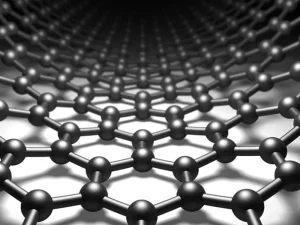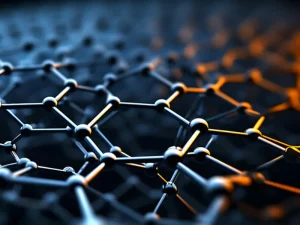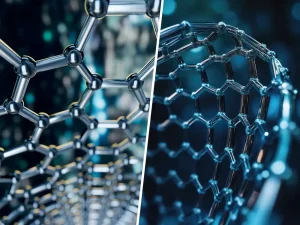Graphene and carbon nanotubes are unique carbon-only structures. Graphene is an extremely thin, flat material, like a tiny sheet of paper. It’s an excellent conductor of electricity, so electricity travels through it fast. Carbon nanotubes are little tube-shaped structures built out of carbon. They’re light as a feather but far stronger than steel. These materials help enhance technology, from computers to cars to space travel. Small as they are, they pack a punch and could reshape the future in remarkable ways.
What is Graphene?

Graphene is an allotrope of carbon. It is so fine, nearly invisible yet extremely sturdy. It is strong but also lightweight and flexible. Graphene is useful for lots of things because it bends before it breaks. Graphene is an excellent conductor; thus, electricity can easily pass through it. Scientists are thrilled about the potential uses of new devices. Graphene is one of the most remarkable materials known today, even though you can’t see it. Follow-up studies are being conducted to make even more advanced technologies in the future.
What are Carbon Nanotubes?

Carbon nanotubes are small tubes built from carbon atoms. They are so tiny that you cannot see them with the human eye yet, but they are super strong. Their stereotype is stronger than that of metal yet light types. They also conduct electricity extremely effectively. Scientists use carbon nanotubes in various fields, including technology and medicine. These little tubes enable researchers to make exciting discoveries. Scientists are exploring new ways to harness them to enhance products.
Graphene VS Carbon Nanotubes
The difference between carbon nanotubes and graphene is in their properties. Let us know more about the properties.
Properties of Graphene
Graphene has special properties that excite scientists. It has opened new horizons for scientists to develop new, better things. These are properties that can make it useful for making new materials. Graphene has the following characteristics:
- Lighter Than Metal: It is quite strong and lightweight.
- Very Small: Small enough that the human eye can not see it.
- Flexible: It can bend without breaking.
- Good Conductor: Electricity passes through it relatively quickly.
- Heat Resistant: It catches on fire and melts at high temperatures.
- Durable: It is also durable, meaning it lasts without getting damaged for a long time.
Carbon Nanotubes Properties
All you need to know is that carbon nanotubes also possess unique properties. These properties make them valuable across many different industries. Here are some of their main features:
- Super Strong: They are much harder than diamonds and lighter.
- Very Thin: They are almost undetectable by the human eye.
- Resilient: They bend but do not break.
- Great Electrical Conductor: They can conduct electricity almost immediately.
- High Resistance: They do not melt easily or burn.
- Withstand the Test of Time: They are durable and do not wear down easily.
How Long Have These Materials Been Used?
Graphene:
Two scientists from the University of Manchester — Andre Geim and Konstantin Novoselov — discovered graphene in 2004. They won a big science prize in 2010 for their discovery, which was so important. Since its discovery, scientists have been working on new applications of graphene.
Carbon Nanotubes:
Carbon nanotubes were first discovered in 1991 by the Japanese scientist Sumio Iijima. But scientists had seen other tiny tubes as far back as the 1960s. After their official discovery in 1991, these nanotubes became highly significant. Today, they are used in nanotechnology, materials science, and electronics.
Applications- Carbon Nanotubes VS graphene
Graphene and carbon nanotubes are changing the way products are manufactured. They increase the strength-to-weight ratio and efficiency of materials. Scientists are always finding new uses for them. The difference between graphene and carbon nanotubes makes them useful in different ways.
Graphene: What They Are Used For
Graphene is a very potent material that is now widely used by scientists. Let us know in detail about the uses:
Energy storage
- Used in storage mediums such as batteries.
- Perfect transistors so electronics operate more quickly and efficiently.
- Just a few potential uses: helping create improved touchscreens and flexible displays.
Automotive and Aerospace
- To produce lighter and stronger cars and planes.
- Contribute to better automotive paints and coatings.
Medicine and Biotechnology
- Aid in developing stronger and more flexible medical implants.
- Used in sensors that can detect diseases early.
Energy and Sustainability
- Give solar panels a boost to soak up more sunlight and generate more energy.
- It is essential in water filtration to rid the water of harmful toxins.
Sports Equipment and Textiles
- It’s used to make strong yet lightweight sports gear, such as tennis rackets and bikes.
- Assist in the creation of smart fabrics that monitor health and motion.
Construction and Coatings
- Fortify construction materials such as concrete.
- Assist in developing coatings to stop rusting and such damage to bridges, pipes, and ships.
Carbon Nanotubes: What They Are Used For
Carbon nanotubes are also helping many industries. It is creating stronger, lighter, and more efficient materials. New uses are being devised all the time by scientists. There are some notable applications here:
Electronics, semiconductor
- Contribute to the development of electronics that are smaller and faster.
- Develop better batteries and energy storage devices.
- Commonly used for flexible screens and touch panels.
Aerospace and Automotive
- Contribute to making planes and automobiles lighter and more sturdy.
- Increase tire life and fuel economy.
- Used in heat-resistant paints for spaceships and satellites.
Medicine and Biotechnology
- Utilized in enhanced drug delivery system.
- Make medical implants more AI-friendly.
- Sensors for early detection of diseases.
Energy and Sustainability
- Assist in storing toxic materials to prevent pollution.
Sports Equipment and Textiles
- Applied in lightweight but strong sports gear like bicycles, rackets, and helmets.
- For smart-wear clothing fabrics.
Construction and Coatings
- Increase the strength of concrete and other building materials.
- They are used in protective coatings for bridges and pipelines.
What Is the Importance of These Two Materials?
Graphene and carbon nanotubes’ distinguishing properties are the basis of systems in many industries. They are lightweight, strong, and conductive materials. They can be used in electronics, medicine, energy, construction, and even space technology. These materials will remain critical in science and industry for many decades.
Conclusion
Graphene is both light and a great electrical conductor. It is useful in flexible screens, batteries, and other electronic segments. On the other hand, carbon nanotubes are extremely strong and elastic. They are found in medical devices, also in protective coatings, and high-technology applications.
What we learn from these materials will result in next-generation products. With their assistance, industrious and supercilious will forge superior materials. They are melt into cleaner energy and the best technology. Their potential is still under study, guiding us to a more intelligent and greener world!

